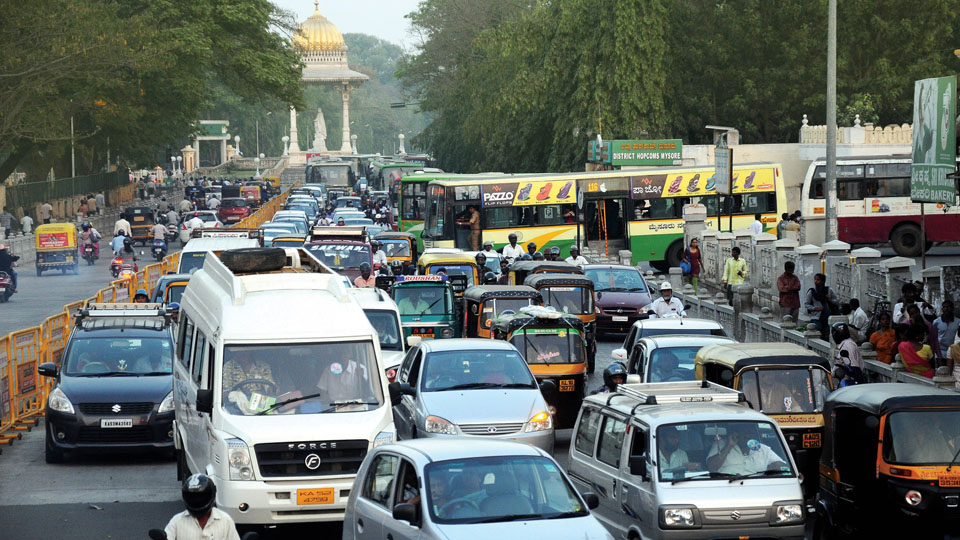By R. Chandra Prakash, MGP
Today, roads in city’s Central Business District (CBD) are clogged with heavy traffic. Most of these roads have been widened to maximum permissible limits to the total disadvantage of pedestrians. Parked vehicles occupy more than two thirds of these roads.
We have a wide range of vehicles occupying every inch of space on these roads and most of the drivers are least bothered to follow road rules. No surprise that the traffic situation is chaotic. In fact, it adversely affects business, which is the mainstay of CBD. But the point here is how have we reached this pathetic condition in a sleepy town, known till recently as Pensioners’ Paradise? Answer to this question is found in the city’s recent ‘development’ history.
Vehicle Boom Years
As per information from two Regional Transport Offices (RTOs) as on 30th September 2017, the city has 8,65,159 vehicles registered. Of these, 80.90 percent were two-wheelers, 11.32 percent were motor cars, 2.64 per cent autorickshaws, 2.03 percent goods carriage vehicles and 1.05 per cent delivery vans. Other vehicles such as maxi cabs, buses and contract carriages accounted for less than 1 per cent.
Significantly, the ten-year period of 2007 to 2017 showed unprecedented escalation in vehicle registration. More than 57 percent of 6,91,840 two-wheelers were those registered between 2007 and 2017. Similarly, 72 per cent of motor cars, 77 per cent of goods vehicles, 36 per cent of autorickshaws, 42 per cent carriages and 38 per cent of motor cabs were registered during the same period.
Thus it is obvious that 2007-2017 was vehicle boom period. Due to the very manner in which the business has developed in the city over the period and also due to the structure of our city centre roads, CBD gets the highest traffic density. And this is the reason for vehicular mayhem there.
Period of “Reports”
Interestingly, the very same ten-year period was also a time which saw the emergence of several “Reports.” These reports could have prevented vehicular congestion in CBD. But unfortunately they did not as authorities failed to take follow up action. Only three such reports, which had great significance to CBD are referred to here.
Report on Comprehensive Traffic and Transportation Plan for Mysuru
In 2008, Department of Urban Land Transport [DULT] brought out a Comprehensive Traffic and Transportation Plan (CTTP) for Mysuru from 2009 till 2028. The CTTP set in place implementable proposals. It is the basis for development of the city and reflects upon the key interventions to be proposed. The CTTP is a policy document that has addressed transportation issues.
The report’s assessment of existing public transport was as follows:
The bus route network is based on ‘Hub and Spoke’ pattern with routes starting from various parts of the city, operating on radials which are fanning out from the city centre and terminating at the city bus terminal. So all the passengers, who are destined for places other than CBD have to come to CBD to take a changeover as all the routes terminate at city centre. This creates acute congestion. The existing route network was good when the city was small. With growth, there is a need to change the routing pattern to facilitate changing travel pattern. This was a very accurate assessment of the existing situation nearly a decade ago, also at a time when the private vehicle boom was still in the nascent stage.
The CTTP recognised the heritage significance of the city centre and stated as follows:
The Mysore Palace has created a special interest for the tourists over thousands of years in the past. At present, the city core is losing its charm as the roads around this Palace have been encroached and haphazardly commercialised. The City Bus Stand (CBS) operating just beside the Palace has made the place congested and the vehicles parked on the roads have worsened the condition.
If only these observations were taken note and necessary steps taken, the city could have avoided the vehicular mess at the CBD. On the contrary, KSRTC ignored these observations and went on to build large new city bus station at the K.R. Circle, as also suburban bus station on Bengaluru-Nilgiri Road.
Nearly 600 buses operate from the city bus station and more than one lakh passengers embark and disembark here every day. More than 2,000 buses arrive and leave Sub-urban Bus Station and more than 2 lakh passengers embark and disembark here. Both these bus stations are located within less than one kilometre from each other within the CBD. Any surprise that the city is facing acute congestion?
CTTP’s development plans also included a parking lot which is intended to relieve the city centre of the substantial traffic congestion while serving to be a boost for development of business in the city core and rejuvenate the old-parts of the city.
There cannot be two opinions that the location of a multi-level parking complex at Town Hall was an act of murder. But not completing it even after 8 years is an unpardonable crime. Mysuru City Corporation (MCC), the executing authority of this wanton project, should be squarely held responsible for a brazenly callous act which smacks of corruption.
Though there is no doubt that CTTP Report looked deeply into other traffic and transport issues of Mysuru, it never got implemented and there is no guarantee that its recommendations will see the light of the day.








Recent Comments